高中英语人教版必修二学案:Unit 4 Writing
人教版(2019)新教材高中英语必修第二册第四单元词汇学案
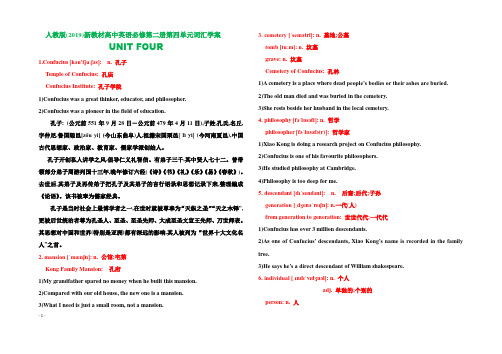
人教版(2019)新教材高中英语必修第二册第四单元词汇学案UNIT FOUR1.Confucius [kən'fjuːʃəs]: n. 孔子Temple of Confucius: 孔庙Confucius Institute: 孔子学院1)Confucius was a great thinker, educator, and philosopher.2)Confucius was a pioneer in the field of education.孔子: (公元前551年9月28日-公元前479年4月11日),子姓,孔氏,名丘,字仲尼,鲁国陬邑[zōu yì] (今山东曲阜)人,祖籍宋国栗邑[ lìyì] (今河南夏邑),中国古代思想家、政治家、教育家、儒家学派创始人。
孔子开创私人讲学之风,倡导仁义礼智信。
有弟子三千,其中贤人七十二。
曾带领部分弟子周游列国十三年,晚年修订六经(《诗》《书》《礼》《乐》《易》《春秋》)。
去世后,其弟子及再传弟子把孔子及其弟子的言行语录和思想记录下来,整理编成《论语》。
该书被奉为儒家经典。
孔子是当时社会上最博学者之一,在世时就被尊奉为“天纵之圣”“天之木铎”,更被后世统治者尊为孔圣人、至圣、至圣先师、大成至圣文宣王先师、万世师表。
其思想对中国和世界(特别是亚洲)都有深远的影响,其人被列为“世界十大文化名人”之首。
2. mansion [ˈmænʃn]: n. 公馆;宅第Kong Family Mansion: 孔府1)My grandfather spared no money when he built this mansion.2)Compared with our old house, the new one is a mansion.3)What I need is just a small room, not a mansion. 3. cemetery [ˈsemətri]: n. 墓地;公墓tomb [tuːm]: n. 坟墓grave: n. 坟墓Cemetery of Confucius: 孔林1)A cemetery is a place where dead people’s bodies or their ashes are buried.2)The old man died and was buried in the cemetery.3)She rests beside her husband in the local cemetery.4. philosophy [fəˈlɒsəfi]: n. 哲学philosopher [fəˈlɒsəfə(r)]: 哲学家1)Xiao Kong is doing a research project on Confucius philosophy.2)Confucius is one of his favourite philosophers.3)He studied philosophy at Cambridge.4)Philosophy is too deep for me.5. descendant [dɪˈsendənt]: n. 后裔;后代;子孙generation [ˌdʒenəˈreɪʃn]: n.一代(人)from generation to generation: 世世代代;一代代1)Confucius has over 3 million descendants.2)As one of Confucius’ descendants, Xiao Kong’s name is recorded in the family tree.3)He says he’s a direct descendant of William shakespeare.6. individual [ˌɪndɪˈvɪdʒuəl]: n. 个人adj. 单独的;个别的person: n. 人- 1 -people: n. 人; 民族1)An idiom is an expression which means something different from the meaning ofthe individual words.2)Sometimes I feel that individuals can have little effect on such hugeenvironmental problems.3)The museum is open to both teams and individuals.7. heel [hiːl]: n. 足跟; (脚/袜子/鞋等的)后跟Achilles’ [əˈkili:z] heel: (喻)(希腊神话)阿喀琉斯的脚跟; 致命的弱点1)English is his Achilles’ heel.2)Lucy’s Achilles’ heel is that she cannot believe in others.3)She will buy shoes with a low/high heel.阿喀琉斯的脚跟/之踵[zhǒng]阿喀琉斯, 是凡人英雄珀琉斯和海洋女神忒[tè]提斯的爱子。
人教课标版高中英语必修二 Unit4 Writing 教案-新版

Unit4 Writing 教学设计1. Teaching Analysis 教情分析1)Teaching objectives-教学目标①Ability goals能力目标a. Students will be able to draw mind map to generate more ideas and get rid of traditional linear way of thinking.b. Students will learn to write a passage by employing the process-oriented approach.②Emotion goals情感目标Students will have the awareness of wildlife protection and advocate more people in the protection.Students will think about the solution of wildlife protection.2)Important & difficult teaching points-教学重难点Students earn to write a passage by employing the process-oriented approach.2. Student analysis学情分析1)Fundamental state基本情况Students have got used to the old-fashioned way of writing apassage---product-oriented approach. The product of a passage is placed in the first place and little attention is paid to how a passage is developed. Therefore many students feel it boring and tiring to write a passage. Indeed armed with a large vocabulary and creative ideas, they have the ability to work out but there is no such way for them to do so.2)Knowledge reserve知识储备After the first 4periods of learning, students have abundant language input and acquire adequate information about wildlife protection to output---write a passage. Besides, many of them have a large vocabulary and creative ideas3. Teaching methods教法建议Process-oriented approach, cooperative teaching method, situational teaching approach情景教学法4. Teaching Aids教学辅助Blackboard and chalk, computer or I-pad, projector5.Teaching procedures-教学进程Step I Pre-writing1. BrainstormingIt’s a pity in t he story that nobody helped the dodo. But there are still some endangered animals that are in need of our protection. So please write a letter to WWF to help you save the endangered animals. The students are to think about the endangered animals they want to save. Meanwhile teachers are to write down what students come up with and then several endangered animals are shown in PPT.2. Mind-mapStudents are to discuss and think about some questions about endangered animals.Step II Free-writingStudents are to write what is in their mind according to the mind mapThe teacher then invites some students to report their sentence. If there are some beautiful words and expressions, the teacher can write down on the blackboard.Step III SamplesThe teacher introduces the form of letter and some useful expressions to facilitate students’ writing.① Expressing intentionI’m going to I will I’d rather not I feel like... I’d like toI intend /mean/plan to... I’m ready to...② Expressing purposeTo help/save so that but do to protect from in order toto teach them a lesson to punish those who do harm to wildlifeStep IV OutlineStudents are to write an outline of their letter. And the teacher could help them with the chart.Step V DraftingStudents are to write the first draft based on the ideas and discussion above.Step VI Peer editingStudents are to swap their writing with partners to check the spelling, grammar and punctuation and find out the highlights. Then students are encouraged to report the highlights they find in peer editing. At this time, teacher can give compliments, take down the report and refine theses sentences.Step VII RevisingStudents are to swap the writing back and revise their own letter by correcting the mistakes and polishing their sentences.Step VIII Teacher’s feedback (grading)The teacher collects the students’ compositions and then ticks the mistakes and highli ghts the good points. And it’s better for the teacher to write down some specific and genuine reviews.Next time the teacher can show some quality compositions and point out some common mistakes.。
人教版高一英语必修二Unit4 写作课 课程教学设计
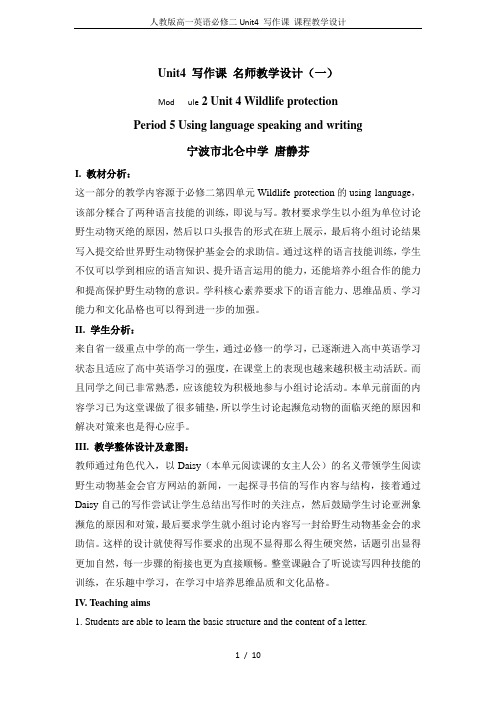
Unit4 写作课名师教学设计(一)Mod ule 2 Unit 4 Wildlife protectionPeriod 5 Using language speaking and writing宁波市北仑中学唐静芬I. 教材分析:这一部分的教学内容源于必修二第四单元Wildlife protection的using language,该部分糅合了两种语言技能的训练,即说与写。
教材要求学生以小组为单位讨论野生动物灭绝的原因,然后以口头报告的形式在班上展示,最后将小组讨论结果写入提交给世界野生动物保护基金会的求助信。
通过这样的语言技能训练,学生不仅可以学到相应的语言知识、提升语言运用的能力,还能培养小组合作的能力和提高保护野生动物的意识。
学科核心素养要求下的语言能力、思维品质、学习能力和文化品格也可以得到进一步的加强。
II. 学生分析:来自省一级重点中学的高一学生,通过必修一的学习,已逐渐进入高中英语学习状态且适应了高中英语学习的强度,在课堂上的表现也越来越积极主动活跃。
而且同学之间已非常熟悉,应该能较为积极地参与小组讨论活动。
本单元前面的内容学习已为这堂课做了很多铺垫,所以学生讨论起濒危动物的面临灭绝的原因和解决对策来也是得心应手。
III. 教学整体设计及意图:教师通过角色代入,以Daisy(本单元阅读课的女主人公)的名义带领学生阅读野生动物基金会官方网站的新闻,一起探寻书信的写作内容与结构,接着通过Daisy自己的写作尝试让学生总结出写作时的关注点,然后鼓励学生讨论亚洲象濒危的原因和对策,最后要求学生就小组讨论内容写一封给野生动物基金会的求助信。
这样的设计就使得写作要求的出现不显得那么得生硬突然,话题引出显得更加自然,每一步骤的衔接也更为直接顺畅。
整堂课融合了听说读写四种技能的训练,在乐趣中学习,在学习中培养思维品质和文化品格。
IV. Teaching aims1. Students are able to learn the basic structure and the content of a letter.2. Students are able to train their speaking ability and thinking ability through discussion in groups.3. Students are able to train their writing ability through independent writing, correcting others’ and polishing.4. Students are able to raise their awareness of wildlife protection.V. Important points and difficult points1. It’s important to help the students learn the structure and content of a letter and also important to train their speaking and writing ability.2. It’s difficult for students to get the entire content of the letter, especially appropriate reasons and solutions.VI. Teaching proceduresStep 1: lead-in1. Daisy’s self-introduction:“Hello,I’m Daisy! Still remember me? I’m the girl who is really concerned about endangered species.”2. Daisy’s good news:“Yesterday, I searched the official website of WWF and I saw the good news Learn about us and get fund. Wow! I’m interested in it. I’m eager to get involved! Let’s read the news together.”Learn about us and get fund!For more than 50 years, WWF has been protecting the future of nature. The world's leading conservation organization, WWF works in 100 countries and is supported by almost five million members worldwide.Now good news comes. We are going to offer 10% of our donation to some programs of worldwide conservation activities. If you want to help save some rare animals, please share with us their endangered situations and what you can do to protect them. Later we will estimate whether we should support them or not. Now take action and *************************************.设计意图:角色代入Daisy,使学生对老师更有一种亲近感,营造了朋友间的交流氛围和沟通模式,增加了师生间的互动。
人教版必修2Unit 4 Writing
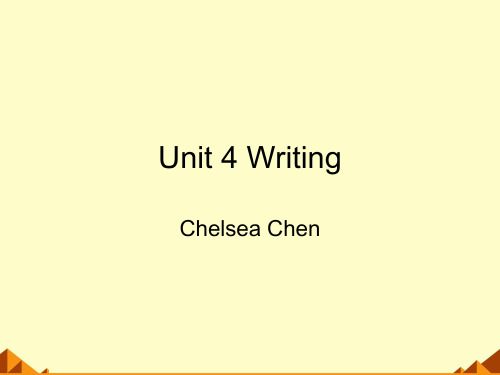
Sincerely,
Cheers,
Sincerely yours, Regards,
Yours truly,
Best wishes,
Yours faithfully, Yours,
Take care,
Pre-writing-Formal and Informal
2. 词语的运用
Formal:使用正式 的词语,如:
结构上往往要求“一个要点一个段落” 的体例
Informal:使用第一人称
Panda
South China tiger
golden monkey
What's the problem of these animals commonly facing?
They are dying out./They are endangered.
3.缩略形式
Formal:避免使用缩略形式
(contractions)
Informal:使用缩略形式(contractions),
如I’m, there’re, you’re etc)
Pre-writing-Formal and Informal
4.第一人称和内容结构
Formal:避免使用第一人称。在内容
I’m ready to
I ‘d rather not…
Purpose To help/save… to protect…from… so that…
in order to … but do…
to teach them a lesson
to punish those who do
Dto protect wild animals?
Not to over kill wildlife. Not to pollute our environment. Not to over cut forest. To collect money to help them. To build nature reserves(保护区). …
人教课标版高一英语必修二unit4Section Ⅴ Writing精品课件
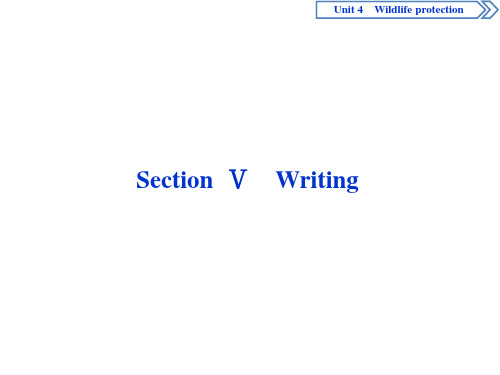
____________________________________________________
____________________________________________________
Regards,
Li Hua
栏目 导引
Unit 4 Wildlife protection
栏目 导引
Unit 4 Wildlife protection
高级表达 I am writing to apply for(申请) the position of ...,which was advertised in ... Learning from ... that you are looking for ..., I would like to ... In answer to your advertisement, I wish to apply for the post of ... in your company.
member of ...
purpose of/with the hope of ...
I can tell ... about ... I will be able to tell ... about... and
and learn about... too. learn about ... as well.
栏目 导引
注意:
Unit 4 Wildlife protection
1.词数 100 左右;
2.可以适当增加细节,以使行文连贯;
3.邮件开头和结尾已为你写好,但不计入总词数。
Dear Sir or Madam,
____________________________________________________
人教版必修二unit4教案
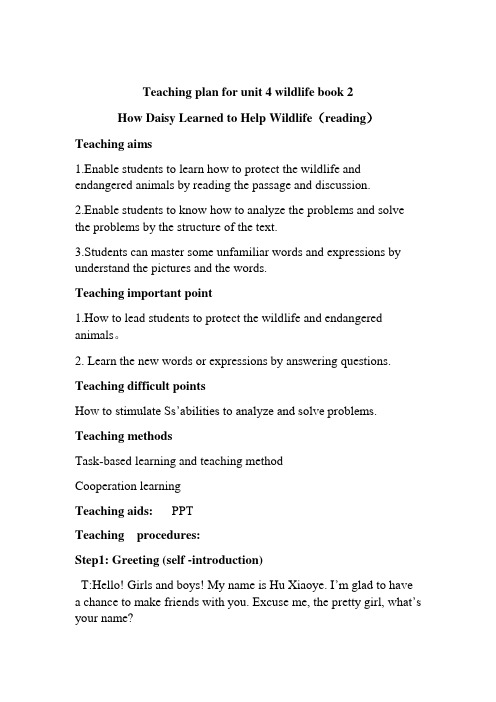
Teaching plan for unit 4 wildlife book 2How Daisy Learned to Help Wildlife(reading)Teaching aims1.Enable students to learn how to protect the wildlife and endangered animals by reading the passage and discussion.2.Enable students to know how to analyze the problems and solve the problems by the structure of the text.3.Students can master some unfamiliar words and expressions by understand the pictures and the words.Teaching important point1.How to lead students to protect the wildlife and endangered animals。
2. Learn the new words or expressions by answering questions. Teaching difficult pointsHow to stimulate Ss’abilities to analyze and solve problems. Teaching methodsTask-based learning and teaching methodCooperation learningTeaching aids:PPTTeaching procedures:Step1: Greeting (self -introduction)T:Hello! Girls and boys! My name is Hu Xiaoye. I’m glad to have a chance to make friends with you. Excuse me, the pretty girl, what’s your name?S1:…T:Thank you! Today, I’ll invite all of you to vis it some animal friends in the forest. Can you come with me?Ss: Yes! T:Ok,let’s go to the forest.Step2:Lead-inT:Listen to the sounds of animal and guess what kind of animal it is?Ss:An elephant、a tiger、a monkeyT: Pretty good! And the last one is a panda. The animals live in the forest, in the wild so they are wildlife. Wildlife includes wild plants and wild animals. Can you guess out all of the wildlife?Ss:No. T:I know most of us can’t guess them all. Can we often see them in the forest?Ss: No. T: So w hat’s happening to the wildlife? Ss: They are in danger.T:Excellent! They are in danger of disappearing or endangered. They are dying out! Now, let’s have a look at another endangered animal. They are antelopes. Look, there were so many antelopes, but, please look at this one, there is only one. So we can say “the number of endangered antelopes becomes smaller and smaller. The number of endangered antelopes becomes decreases.” Why are the animals endangered? (showing four pictures: hunt、destroy the habitats、pollute ) How about the panda ?(showing the picture of a hungry panda)Ss: She is hungry. T:Right! She is very hungry. let’s save her. What food do pandas eat?Ss: Bamboos T: Yes. Now Let’s plant bamboos for the panda in my class. Every group can get one part of a bamboo by answering the questions correctly. Four parts of a bamboo can become a tree. Clear?Ss: Yes! T:It is an organization called WWF, World Wildlife Fund. It’s helping wildlife now. Do you want to join it to help wildlife? Today, let’s learn to help wildlife with anotherfriend ,Daisy in the reading on page 26.Step 3 ReadingT:From the picture we can see the girl named Daisy , let’s make a magical trip by a flying carpet.(showing a picture of flying carpet).And she went to many places of the world.(showing the map) Because there are so many countries with endangered animals, especially China. Are you curious about her trip?Ss:Yes! T:Ok,let’s have a look what happened.Task1:SkimmingT:Please skim the reading passage and choose the right answer. You can get three points.(pointing at the smiling face) Come on boys and girls!(after three minutes) Which one do you choose?Ss: C T:perfect! You can get three points. Congratulations ! Task 2 :scanningLet’s continue. We know the passage is about Daisy’s journey, so please find out the first stop of her journey, and what animal did she see.(one minutes later) Have you find the right answer?Ss:Yes. T:Please hands up. How about this boy?Ss:The fist stop is Tibet and the animal is an antelope.T:well done! I’ll give you two points. Ok, let’s continue. Are you ready for the second chance.Ss:Yes. T:very good! where did she go next and what animal did she see.(one minute later) Have you find the right answer?Ss:Yes. T:this girl, pleaseS4:she went to Zimbabwe and she saw elephants.T: wonderful, sit down please. let’s do the next task together. Where did she go last and what animal did she see?Ss: She went to the rainforest and she saw monkeys.T:Everyone did a great job. let’s read the passage carefully.You have know the main topic of each paragraph. Let’s match each paragraph with the main idea. You can discuss your partners. I’ll give you three minutes to finish the task. Have you finished?Para1 What we can get from wildlife protection.Para2 What’s happening to antelopes?Para3-4 How the government of Zimbabwe protected the wildlife.Ss: Yes.T:Any volunteer? Good, this girl.S5:para 1 is what is happening to antelopes.Para 2 is how the government of Zimbabwe protected the wildlife? Para 3 is what we can get from wildlife protection.Task 3 careful readingT:perfect!Now let’s move on careful reading. read the first paragraph carefully and fill in the blank.(two minutes later) any volunteer?Good,this boy.S6:..............T:very good. You will get one point for each. let’s look at paragra ph 2 and finish the task. The elephants destroyed farms so…. You can choose the result from A,B,C.Find the result for the following three sentences.1. The elephants destroyed farms. ( )2. Tourists are allowed to hunt a few animals. ( )3. The farmers no longer kill the elephants.( )A. The farmers happily get the money paid by tourists .B. The numbers of the wildlife are increasing.C. The farmers hunted the elephants without mercy.S7:...T:Good job! L et’s read part 3 and answer the two questions for four minutes. Any volunteer?1.Can we get the drug from millipede without the monkey’shelp?2. What is the drug used to?S8:.....Task 4 ConsolidationT: Let’s learn more about the article structure. Wildlife protection is a problem. So how do we read this kind of passage? Do you remember the main idea of each part? Part1 is what is happening to antelopes. It shows wildlife in a bad situation, so it is about situation. Para 2 is how the government of Zimbabwe protected the wildlife? It tells us a way to solve the situation, so we call it solution. Para 3 is what we can get from wildlife protection. It is result.Task 5 Choose and discussT:Now we have learned the passage. let’s check whether you are familiar with it. Here are three pictures. Each picture stands for each part. Please choose one and finish the task.(six minutes later) Picture One(5scores)1. What is happening to antelopes?--- situation2. How can we help them? --- solutionPicture Two(5)1. What is happening to elephants?2. Do you agree with the government in Zimbabwe? Why? Why not?Picture Three(8)1. Is the rainforest being destroyed? --- situation2. How can we solve the problem? --- solution.3. What can we get from the rainforest?--- resultAll of you have done a good job. Now the group lead, please read your own discussion in front of the class. Thanks to your help, she has so many bamboos to eat so the hungry panda is very happy now. Group….You did the greatest contribution to her food. I’d like to give you a prize. The group leader, please draw a smile mouth for the panda. All have done a good job. I will give all of you a gift. Thegift is watching a video.(showing a video about WWF)Let’s read the sentences.Pandas are happy.Nature is happy.Human beings are happy.No protection, no wildlife, no human beings!Let's leave our children a living planet!.Step 6 Homework1.Write a passage about wildlife protection.2.Find out more information on WWF.Step7 Blackboard designPart1 What’s happeningPart2 How …solve…Part3 What…get… G1 G2 G3 G4 G5 G6Step7 教学反思学生能在规定的时间内完成阅读任务,对文章的脉络有个基本的了解。
人教版高中英语必修二unit4学习教案

人教版高中英语必修二unit4学习教案一、教学内容二、教学目标1. 学生能够理解并掌握阅读材料中的生词和短语,如:oxygen, generate, climax等。
2. 学生能够运用一般现在时和一般过去时描述云的形成过程及特点。
3. 学生能够运用所学知识,进行有关天气和自然现象的讨论。
三、教学难点与重点1. 教学难点:一般现在时和一般过去时的运用,以及使用“It”作为形式主语的句子结构。
2. 教学重点:云的形成过程、特点以及与之相关的词汇和表达。
四、教具与学具准备1. 教师准备:PPT、黑板、粉笔、阅读材料。
2. 学生准备:课本、笔记本、字典。
五、教学过程1. 导入:通过展示一组有关天气和云的照片,引导学生讨论天气和云的特点。
2. 阅读与思考:学生阅读“A Day in the Clouds”一文,并完成相关练习,教师进行讲解。
3. 例题讲解:讲解一般现在时和一般过去时的运用,以及使用“It”作为形式主语的句子结构。
4. 随堂练习:学生完成Discovering Useful Structures部分的相关练习,教师进行点评。
5. 小组讨论:学生分组讨论,运用所学知识描述云的形成过程及特点。
六、板书设计1. Unit 4 A Day in the Clouds2. 词汇:oxygen, generate, climax等3. 句子结构:一般现在时、一般过去时,使用“It”作为形式主语七、作业设计1. 作业题目:根据课堂所学,写一篇关于云的形成过程及特点的短文。
2. 答案要求:使用一般现在时和一般过去时,不少于100词。
八、课后反思及拓展延伸1. 教师反思:关注学生在课堂上的参与程度,调整教学方法和节奏,以提高教学效果。
2. 拓展延伸:鼓励学生关注天气变化,观察云的形态,提高英语实际应用能力。
重点和难点解析1. 教学难点:一般现在时和一般过去时的运用,以及使用“It”作为形式主语的句子结构。
2. 例题讲解:讲解一般现在时和一般过去时的运用,以及使用“It”作为形式主语的句子结构。
高中英语人教版必修二学案:Unit 4 Writing
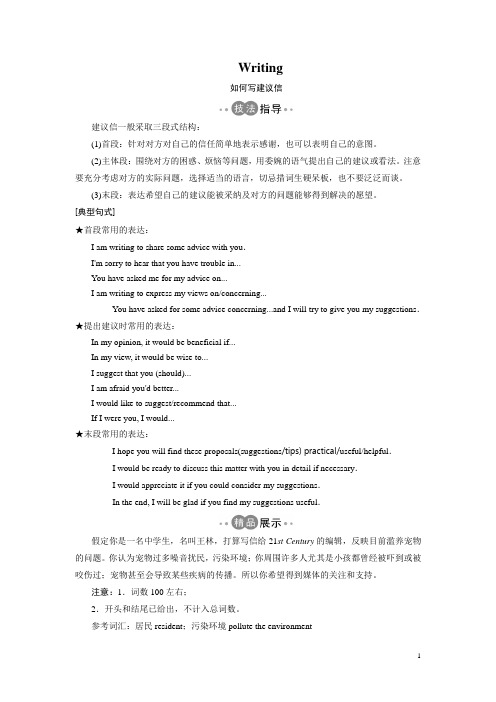
Writing如何写建议信建议信一般采取三段式结构:(1)首段:针对对方对自己的信任简单地表示感谢,也可以表明自己的意图。
(2)主体段:围绕对方的困惑、烦恼等问题,用委婉的语气提出自己的建议或看法。
注意要充分考虑对方的实际问题,选择适当的语言,切忌措词生硬呆板,也不要泛泛而谈。
(3)末段:表达希望自己的建议能被采纳及对方的问题能够得到解决的愿望。
[典型句式]★首段常用的表达:I am writing to share some advice with you.I'm sorry to hear that you have trouble in...You have asked me for my advice on...I am writing to express my views on/concerning...You have asked for some advice concerning...and I will try to give you my suggestions.★提出建议时常用的表达:In my opinion, it would be beneficial if...In my view, it would be wise to...I suggest that you (should)...I am afraid you'd better...I would like to suggest/recommend that...If I were you, I would...★末段常用的表达:I hope you will find these proposals(suggestions/tips) practical/useful/helpful.I would be ready to discuss this matter with you in detail if necessary.I would appreciate it if you could consider my suggestions.In the end, I will be glad if you find my suggestions useful.假定你是一名中学生,名叫王林,打算写信给21st Century的编辑,反映目前滥养宠物的问题。
- 1、下载文档前请自行甄别文档内容的完整性,平台不提供额外的编辑、内容补充、找答案等附加服务。
- 2、"仅部分预览"的文档,不可在线预览部分如存在完整性等问题,可反馈申请退款(可完整预览的文档不适用该条件!)。
- 3、如文档侵犯您的权益,请联系客服反馈,我们会尽快为您处理(人工客服工作时间:9:00-18:30)。
Writing
如何写建议信
建议信一般采取三段式结构:
(1)首段:针对对方对自己的信任简单地表示感谢,也可以表明自己的意图。
(2)主体段:围绕对方的困惑、烦恼等问题,用委婉的语气提出自己的建议或看法。
注意要充分考虑对方的实际问题,选择适当的语言,切忌措词生硬呆板,也不要泛泛而谈。
(3)末段:表达希望自己的建议能被采纳及对方的问题能够得到解决的愿望。
[典型句式]
★首段常用的表达:
I am writing to share some advice with you.
I'm sorry to hear that you have trouble in...
You have asked me for my advice on...
I am writing to express my views on/concerning...
You have asked for some advice concerning...and I will try to give you my suggestions.★提出建议时常用的表达:
In my opinion, it would be beneficial if...
In my view, it would be wise to...
I suggest that you (should)...
I am afraid you'd better...
I would like to suggest/recommend that...
If I were you, I would...
★末段常用的表达:
I hope you will find these proposals(suggestions/tips) practical/useful/helpful.
I would be ready to discuss this matter with you in detail if necessary.
I would appreciate it if you could consider my suggestions.
In the end, I will be glad if you find my suggestions useful.
假定你是一名中学生,名叫王林,打算写信给21st Century的编辑,反映目前滥养宠物的问题。
你认为宠物过多噪音扰民,污染环境;你周围许多人尤其是小孩都曾经被吓到或被咬伤过;宠物甚至会导致某些疾病的传播。
所以你希望得到媒体的关注和支持。
注意:1.词数100左右;
2.开头和结尾已给出,不计入总词数。
参考词汇:居民resident;污染环境pollute the environment
[写作要点]
第一段:提出要反映的问题,开门见山,直奔主题。
第二段:按照顺序,分析要反映的问题的原因。
第三段:结尾提出自己的要求以引起关注。
Dear editor,
①I'm a middle school student, Wang Lin.②I'm writing to tell you something about the problem of some people keeping too many pets nowadays.
③I consider the problem more and more serious for the following reasons.④First of all, as is known to all, pets make so much noise that they trouble residents a lot.⑤What's more, it's widely accepted that animal wastes pollute the environment which makes people quite uncomfortable.⑥Many owners like taking their pets to public places where they may frighten children or even sometimes bite people.⑦The most important is that pets can spread some diseases and this has attracted much attention.
⑧Taking all these factors into consideration, I sincerely hope that I can get help from you and expect the media to do something for this.
Yours truly,
Wang Lin,
之间过渡自然,连接紧密,开头结尾描述全面。
亮点二:文中句④用了so...that状语从句;句⑤it's widely accepted that为主语从句;句⑦用了表语从句;这些复合句的恰当运用使文章上了一个层次,体现了作者的基本功。
亮点三:使用连接词first of all(句④),what's more(句⑤)使文章更条理化、层次化。
假如你是李华,上周日去动物园,看到游客对动物乱扔石子甚至往一头熊的头上泼水,对此你感到非常气愤。
现在请你用英语就此事给某报社编辑写封信,并提出你的建议,请求该报呼吁人们保护和爱护动物。
注意:词数100左右。
【参考范文】
Dear Editor,
Here I write to tell you about my experience in the zoo last Sunday.I feel terribly sorry and ashamed of what people did to the animals.
There were many animals kept in the zoo and it seemed that they were not being treated well.I saw many visitors throw some stones at them and some visitors even poured water onto a big bear's head.
Here is what we should do.First, we should make people know animals are our friends and important to us.Second,anyone who treats animals badly should be fined.Last but not least,I hope you can help educate people to love and respect animals.Thank you.
Yours sincerely,
Li Hua。
